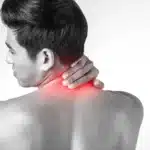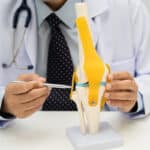
Next time someone tells you that a feeling in their joints is telling them a storm is brewing, you may want to take the prediction seriously. As it turns out, the notion that individuals living with osteoarthritis have a special way to predict the weather might be a bit more than an old wives tale.
As Oklahoma City’s premier source for knowledge on pain management techniques, we have heard of a number of cases regarding patients who claim their knees can predict the weather with greater accuracy than the local news station. Although there is not currently enough scientific evidence to support these claims, they are difficult to discredit altogether due to the overwhelming amount of patient accounts pointing to the contrary.
Those with compromised joints or a weakened musculoskeletal system might be more vulnerable to subtle changes in the environment that might go unnoticed by others. To fully explore this concept, we will have to analyze how factors like rain, humidity, air pressure, and heat affect the body.
How Does Cold Weather Affect Joints?
Several research studies have shown a connection between painful joints and cold weather. These studies have found that arthritis flare-ups during cold weather may be caused by changes in barometric pressure; as the temperature drops, barometric pressure decreases, and OKC is no stranger to sharp drops in temperature. Pain doctors say that this causes the tendons, muscles, and scar tissue surrounding the joints to swell, resulting in pain. This is why we get swollen joints when it’s cold out.
Additionally, cold weather causes the synovial fluid, the fluid that cushions your joints, to thicken -and, in turn, makes the joints stiff and more vulnerable to pain in cold weather. Another study carried out in 2015 showed that during winter, the body boosts its natural defense mechanism, meaning that the immune system begins to produce more inflammatory cells in response to inflammation than it would in higher temperatures.
Dr. Darryl Robinson would agree: this increase in inflammatory cells in patients with arthritis will ultimately lead to joint inflammation and increased pain when it’s cold -especially in Oklahoma City, where the weather rapidly changes.
Humidity & Air Pressure
A drastic increase in humidity commonly causes a shift in atmospheric pressure, which tends to cause discomfort for those who experience regular muscle pain or joint pain. Even individuals with no existing conditions can experience pain due to humidity.
This occurs when your baroreceptors (tiny sensory nerves in the joints) respond to shifts in air pressure, which can drop sharply in rainy weather or high humidity. The sudden pressure drop causes the tendons, ligaments, and muscles to start expanding. Your nervous system quickly responds by altering the rate of blood flow.
Dehydration from Heat
Although an increase in temperature may not have a direct effect on the joints, dehydration due to heat exposure can cause a great deal of discomfort for those struggling with arthritis.
Joint cartilage tissue is somewhere between 70 and 80 percent water, which means your body’s ability to provide the joints with enough cushioning and lubrication depends heavily on your water intake. This is particularly true in the spring and summer months when much of your water is lost through sweat.
What Can I Do About My Osteoarthritis Pain in Cold Weather?
Although researchers only have anecdotal evidence to support the idea that those with arthritic joints may have heightened sensitivity to changes in the weather, the claim is far too common to laugh off as mere superstition. There may very well be a range of weather-related factors with the potential to cause joint pain or discomfort.
Cold weather can cause joint pains to increase, with intensity varying among individuals. But how can cold-weather joint pain be alleviated? One common method used during the winter is staying warm and active without straining the affected joints. While this does help to some extent, it doesn’t give very much relief. A more effective way to manage cold-weather arthritis flare-ups is to get a steroid injection in the affected joint, which you can get here in OKC this winter with Dr. Robinson.
At Oklahoma Spine & Pain Management, steroid injections are used to treat symptoms of arthritis-like pain, which is the most common symptom in both arthritis types. These injections can be used for both inflammatory and non-inflammatory arthritis and are effective for treating both pain and inflammation. Steroid injections are also injected locally into the affected joint for targeted pain relief and are capable of treating severe, debilitating pain. Some steroid injections kick in within hours and can last for weeks, while others kick in after a few days but last longer.
Whatever might be agitating your osteoarthritis symptoms, it is possible to address the condition at its root. Our founder, Dr. Darryl D. Robinson, has been serving the OKC area with state-of-the-art pain management treatments for nearly two decades. Our expert practitioners are specially trained to harness the body’s natural healing power. Experience long-lasting pain relief and renewed mobility without surgery.
Winter is coming in unpredictable Oklahoma City, but Dr. Darryl Robinson at Oklahoma Spine & Pain Management can help you manage your cold-weather pain. If you have arthritis and are worried about the upcoming cold weather, get an appointment for your steroid injection. Why stay in pain when you can be pain-free with only an injection of a steroid by a healthcare professional? It will help you get through this winter with less pain so that you can go about your day without worry. Call (405) 703-4950 to book your cold-weather pain relief appointment in OKC with Dr. Darryl Robinson today!






